Pros
-
Comfortable
-
Fun design
-
Good audio quality for highs, mids, and lows
Cons
-
Only two ear tip sizes included
But while that's true most of the time, the House of Marley Smile Jamaica (available at Amazon for $26.98) in-ear headphones are the exception to that rule. Available in a broad variety of styles/colors, and equipped with decently durable—if not exactly indestructible—materials, the Smile Jamaica in-ears may just have you (and your wallet) wondering, "Is this love?"
The Looks
Marley delivers nine solidly-built and colorful options
While in-ear headphones don't get the same attention as the big over-ears when it comes to design, the Smile Jamaica do a decent job balancing form and function. Available in nine different styles, we particularly enjoyed the complementary color schemes, the FSC-certified wood pegs (on certain styles), and the 4.5-foot, tangle-resistant braided cable.
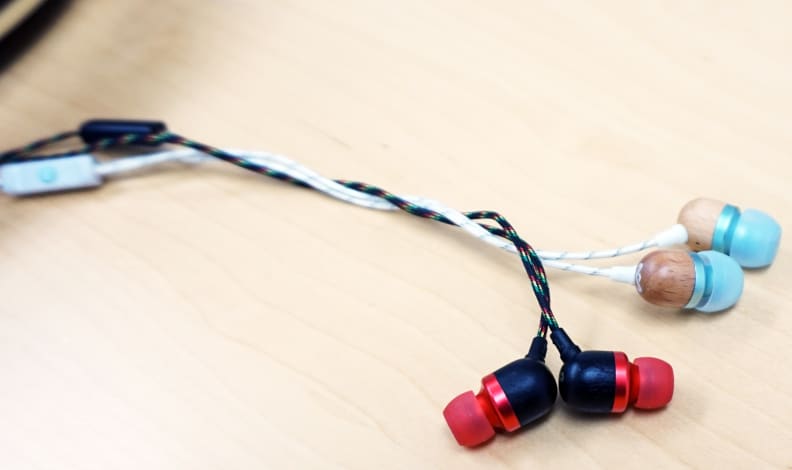
The House of Marley Jamaica Smile in-ears are available in nine color combinations, like Rasta and Copper (pictured).
{{amazon name="House of Marley EM-JE041-MI Smile Jamaica In-Ear Headphone with 1-Button Mic - Midnight", asin="B00G3P9UMU", align="left"}} The Smile Jamaica in-ears come with an in-line remote with a single button and mic, letting you answer/end phone calls and pause/play/skip tracks for your music. While the button has a satisfying click to it and feels like it’ll last for a long time to come, the lack of volume controls is an unfortunate omission. Personally, being forced to fish in my pocket to adjust the volume controls while on a crowded subway is an annoyance I'd rather live without.
Regardless which style/color you go with, the Smile Jamaica in-ears are surprisingly comfortable. Unfortunately, there’s only a single extra silicon tip included in the packaging (beyond the default), so listeners with ears that are larger or smaller than average may be unable to get a perfect fit.
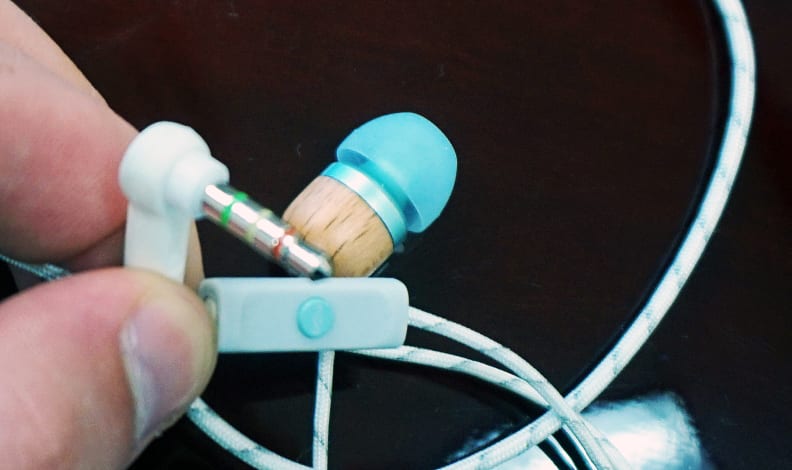
The single-button remote can make remote music/smartphone control a bit of a hassle, but at least the gold-plated jack is highlighted by Jamaican green, yellow, and red.
Still, we think that most people will find these to be perfectly fine. We had five of our coworkers try them out for an hour or two each and they all found them to be acceptable earbuds. If you know you hate earbuds these certainly won't change your mind, but for most people they'll get the job done.
The Sound
Get up, stand up—these Marleys sound awesome
Super cheap in-ear headphones are a dime a dozen, and most people have pretty low expectations of their $20 headphones. Fortunately, these Smile Jamaica buds are something of a redemption song for cheap in-ears everywhere; they're not audiophile quality, but they're exceptional performers for this price range.
When we test headphones, we generally find they fall into one of two camps: flat studio headphones that don't emphasize or diminish any part of the frequency range and consumer-friendly headphones that boost bass slightly and try to provide rich, clear treble response. The Smile Jamaicas, like most low-cost headphones, opt for the latter. They're a little more bass-heavy than most, but nicely follow an equal loudness contour (the blue line in the graph below) matching the natural sensitivity of your ear in the mids and highs.
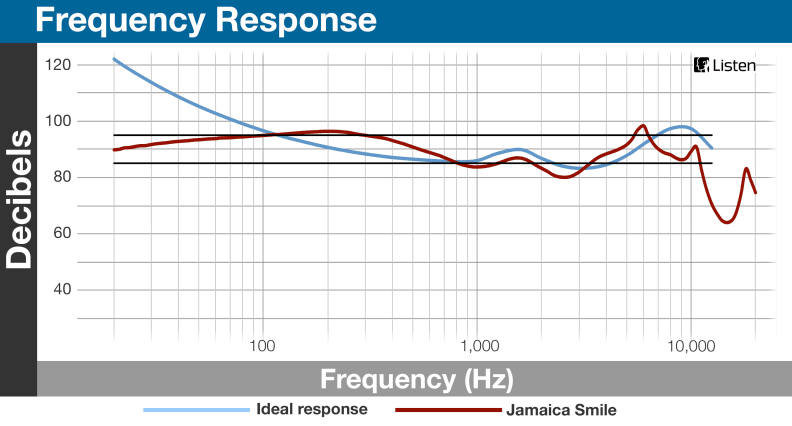
House of Marley Jamaica Smile Frequency Response Curve
Out of the lab, we put the Marleys through the ringer with a wide variety of genres. Everything from Anamanaguchi, to Beethoven, to Mr. Bob Marley himself sounded excellent, and the extra bass emphasis didn't crowd the rest of the landscape. It's a great result, and far above what we expect from affordable in-ears.
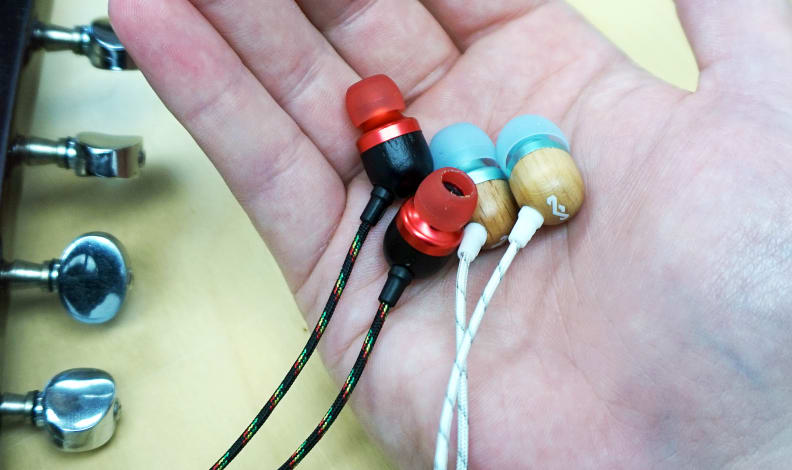
These Marley's provide a consumer-friendly sound with good bass and high treble emphasis, and do a decent job isolating sound without leakage.
From a practical perspective, in-ears like these do the best job at silencing the outside world; after all, squeezing a 'bud into your ear canal does a wonderful job of dampening higher-pitched sounds like chatty commuters. Deeper, rumbling bass sounds—plane engines, truck horns, and the like—will still cut through, but your music should drown those out just as well.
The Bottom Line
A boon companion for navigating the concrete jungle
In-ear headphones can't quite hold a candle to the plushy, high-performance over-ears that dominate the headphone market. But when it comes to getting the most bang for your buck, earbuds are where it's at. And if value is your top priority, the Smile Jamaica in-ears are a superb choice that combine comfort, durability, style, and performance for less than $20.
The Smile Jamaicas aren't perfect, but their consumer-friendly sound profile will reward all sorts of popular and classical genres. Best of all, the design is both fetching and functional, with a braided cable and properly shielded connection points that should ensure your modest investment lasts as long as you need it to.
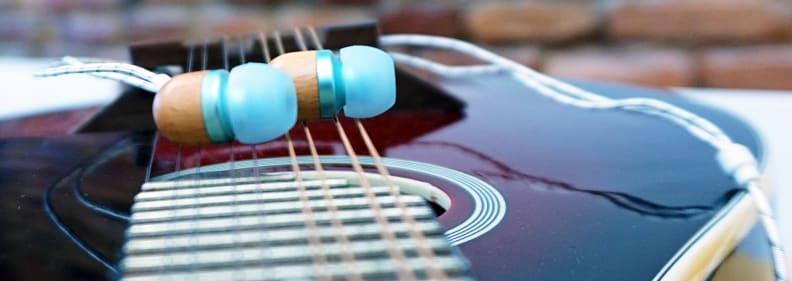
If you like the idea of the Marleys but want just a little better performance, the MEElectronics M9P 2nd Gen. are a great alternative choice. They start closer to $40, but they're on sale so frequently we gave them our Best Headphones Under $25 award this year.
No matter which way you go, however, in-ears like these show that you don't have to pay a lot to get what you want. Both pairs are comfortable, perform well, and should last a long time—just what every shopper needs to satisfy their soul. The House of Marley Smile Jamaica in-ear headphones (MSRP $19.99) are surprisingly good performers for what you're paying. Regardless of which (of nine) color/style options you choose, you can expect a crisp, consumer-friendly sound, good isolation and leakage, and very low levels of THD (distortion).
Frequency Response
The Marley's sound describes what is typically known as an equal-loudness contour, or ELC, wherein the listener perceives a "constant loudness" across the frequency spectrum, from the deepest bass to the tinniest treble. While this is undesirable in a few cases—especially for studio-level sound engineering, or at-home equalizing—it's a trend that most affordable, mass market headphones follow.
The Jamaica Smile in-ears don't quite reproduce the ELC, which normally puts a lot more emphasis on hard-to-hear sub-bass/bass frequencies from 20 to around 200Hz, and extra oomph in the upper treble range around 5.5–6.5kHz. This isn't a bad thing: the less overt over-emphasis or de-emphasis on those frequencies make for a slightly more balanced sound overall. But otherwise, the Marley's stick quite vehemently to the expected emphasis/de-emphasis in an ELC.

House of Marley Jamaica Smile Frequency Response Curve
Distortion
The Marley's tested very handsomely in terms of distortion, or THD (Total Harmonic Distortion), a measure of unwanted mechanical or signal noise present during the operation of speakers. Ideally, headphones will produce less than 3% THD across the majority of the audible spectrum, though many headphones exhibit a higher amount in the lowest sub-bass ranges.
Not only do the Marley's exhibit >3% THD in the 100-10kHz range where it's expected, but they maintain a very low THD even in the more difficult (and more forgiving) sub-bass range. This is an awesome result, especially for $20 headphones.

Passive Isolation
Like most in-ears, the Marley's do a good job shutting out higher pitched (treble) and some midrange sounds, look footfalls and nearby conversations. But likewise, they don't do much to reduce lower, sub-bass and bass frequencies. Testing revealed that up to 20 dB of sound are reduced for midrange sounds, and a healthy 30–35 dB of higher-pitched treble sounds.

Tracking
Tracking refers to the relative volume between a set of headphones' right and left channels. While major discrepancies in tracking are rare for midrange and high-end headphones, they do tend to crop up from time to time in the deep budget range, such as with these Marley's. Fortunately, testing revealed very minor aberrations—less than 5db volume shifts—from balanced tracking into the right speaker. At such low volumes, you'd be hard-pressed to notice these tracking errors.

Meet the testers
Lee was Reviewed's point person for most television and home theater products from 2012 until early 2022. Lee received Level II certification in TV calibration from the Imaging Science Foundation in 2013. As Editor of the Home Theater vertical, Lee oversaw reviews of TVs, monitors, soundbars, and Bluetooth speakers. He also reviewed headphones, and has a background in music performance.
Coming from Buffalo, NY, Nick studied media production and arts journalism. When he’s not writing about tech Nick can be found playing video games and keeping up on the latest in pop culture.
Checking our work.
Our team is here to help you buy the best stuff and love what you own. Our writers, editors, and experts obsess over the products we cover to make sure you're confident and satisfied. Have a different opinion about something we recommend? Email us and we'll compare notes.
Shoot us an email




